Ukindia
Learn to Read Urdu
Learn to Read Urdu
If you have enjoyed doing these lessons and like Ukindia pages and would like to help develop the web site further you might consider a small donation of £3 or $5 once a year. Please send cash in envelopes ( not cheques or money orders as it costs more to process ) to Ukindia, P.O. Box 346 Nottingham , NG8 5FX. All which have an email address will be acknowledged by email.
Lesson 1
Lesson 2..All Urdu lessons -zipped file..Urduword.com English to Urdu translations ..Animated Urdu writing..Home....Asian Books..Tamil.Gujarati. Punjabi. Hindi.Urdu.Sanskrit. Arabic.Greek.English. Russian.Hebrew..Mathematics
Urdu Newspaper
Free Urdu software at http://leb.net/compcorp/pagecom3.zip

Urdu is a very popular language of the subcontinent , second only in the number of speakers to Hindi. It is the national language of Pakistan and an offical language of UP in India . It is the language of poetry and of literature .
You may freely copy these lessons for non commercial uses on to your web site , add sound files or modify them in any way you want - but please do mention Ukindia in them. .All these Urdu lessons on a floppy disk and a Learn to Read Urdu book by Balaji books and a cassette of nearly all the words and phrases and some songs on the lyrics page is available . Send your cheque-total $50 (£25 in UK ) for all items to Ukindia , P.O .Box 346 Nottingham UK , NG85FX . Allow 4-6 weeks for delivery. Send an email at the same time to ukindia
To get to a particular lesson change the address in your browser window . For example change zurdu1.htm to zurdu12.htm to get to Lesson 12 etc.
Urdu is written in the opposite direction to English ie from right to left.
It is an easy language to write fast in , because it has a built in shorthand ! It is very important to read each line slowly and study each part of a figure closely the first time , and then re-read it carefully again to make the whole learning experience easy.
This is the most important lesson so once again do it very slowly and carefully and the rest of the 20 or so lessons will then seem very easy .
Each sound is represented by a letter . For example lets look at the letter K and N in in the next figure.

Each letter is written in a slightly different form depending on whether it comes in the beginning , middle or end of a word or whether it occurs on its own ie in a detached form .
If for example you look at the figure below, K on its own is on your extreme right marked detached . If it occurs in the beginning of a word as in the word Kill it is written as in the next one along -ie its inital form marked 2. If it occurs in the middle of a word eg luKy it is written in the medial form 3 and if it occurs at the end of the word as in ducK it is like the 4th final form to your extreme left.
 .
.The above figure has the detached , initial . medial and final forms of K and N. You may have noted that the detached and final form form are usually very similar.
Note again that the detached form is on your extreme right then the initial , medial and final.
Supposing we wanted to make say a meaningless two letter word with a starting ( initial) letter K and ending with N .

We would take the intial form of K marked 2 in the figure above and the final form of N marked 4 and join them together . Remember to read it R to L.
 .
.Easy isnt it ? .
Vowel marks
Lets add some accent and vowel marks in between the letter K and N . Reading from the right of the screen the second word is k'n with the k pronounced a little longer since the accent mark (zabar) is over the k . The next word kn' has a longer n since the accent mark is over the n . The shapes of the vowels aa, i, ee, u , oo , o , au ,ae and aae are obvious from the figure and are explained in more detail after the figure .
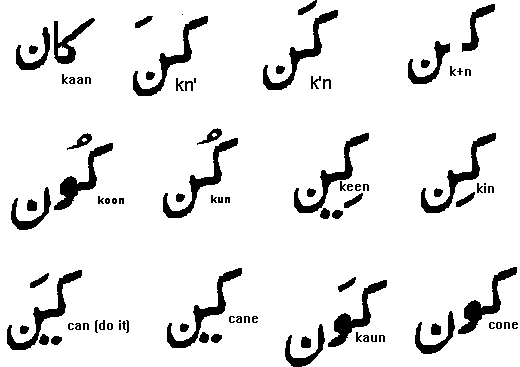
Lets take our meaningless word kn and add vowel marks to it . The left word in the next figure reads kAAn ( ear). The AA is a vertical straight line. A vowel is not joined to the letter following it so the letter n in kaan is written in its detached form . Note also the slight change in the shape of K .
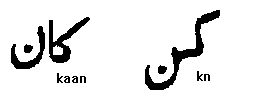
To make kin (as in kith and kin) we put a small slanting mark called ZER below the letter K.
 .
.This vowel mark is often left out in newspapers so when you see kn

you may have to read it as

To write the word kEEn we add two dots to the slanting zer mark
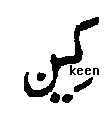
To make the sound u as in kUmar a PESH mark is put over the letter as in this word kUn
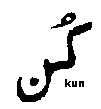
To make the long OO as cOOl another fat worm like mark is put after the letter as well as the pesh above it as in this word kOOn.
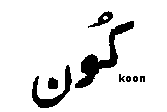
For the mark O as in cOne the worm like mark is on its own without the pesh
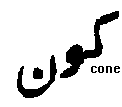
To make the AU sound as in AUtumn the zabar mark is put above the O . The next figure reads as kAUn (who?)

For the AE sound as in cAEn (cane) we write just two dots below the letter.
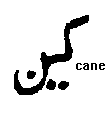
To make the AAE sound we add a slanting zabar above the AE mark.

Note the difference between kEEn and kAEn(cane)


and between kEEn and cAAEn


and between kUn and kAUn


and between kOOn and kAUn


This is a very important area so make sure you get them all right . There is revision of the vowel marks in the figure below. Note however there is a new accent mark called a zabar above the kn word second from your right. It signifies that the accent should be on k so making and not on n in this word here - so it should sound kughn and not knugh. This will become clearer later. Continuing , the third word from R to L on the top line is the word kaan (ear) . The vowel mark AA is a straight vertical line put after K .Note the K changing shape slightly in the figure for KAAN . A vowel mark like AA is not attached to the letter which follows after it , so N here is written on its own.

The vowel mark AA as we noted above is written as a straight vertical line. The next word to it on your left is kin . The vowel mark little i is a small slant line called in urdu ZER is placed BELOW the letter , in this case K. The next word on the second line is KEEN . Two dots are added to the little i - ZER- mark to make a big EE mark below the letter.
Then little u - KUN as in the word crook - the u mark -called PESH- is always above the letter ; next is big U -KOON as in sOOn - note you get a big fat worm like figure added to the little u-pesh- mark , but this worm is on level with the letter.

Next in the figure here

is O as in cone (icecream cone)- the worm on its own makes an O sound ; but when a zabar is added above the letter it makes an Au -KAUN (who in Urdu ) as in AUtumn . Note the difference between the words KOON and KAUN in the bigger figure above. . kOOn has a pesh on top of the worm while kAUn has a zabar on top of the worm.
Next below is ae as in cane (sugar) with two dots below. See if you can spot the difference between the word Cane below and the word KEEN above. Thats right ! , the only difference between an AE vowel mark and an EE one is that EE has an extra zabar in addition to the two dots.This is important to remember.
Last of all in this figure

look again at CANE with the two dots marking the AE sound and the next figure to it CAN . We get the AAE sound in cAAEnada (Canada) by just adding a zabar at the top of the letter
Just go over the vowel marks again. Spend a lot of time sudying the figure below and get up and get it imprinted on your mind. It is extremely improtant to get the vowel marks right . After finishing these introductory lessons red some children's study books. The reason is that newspapers tend to leave out the small vowel marks of little i and little u and tend to put one word on top of another and you will get very confused unless you are confident of your vowels.
The following are the vowel marks which modify the letters.
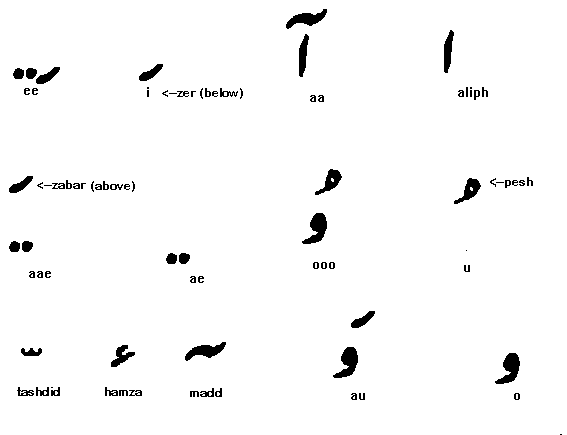
The madd , hamza and tashdid signs are special characters we will look at in the next lesson
Sometimes the letter N when it is the final letter is written without the dot in the middle and is not sounded except from the back of the throat as example in the word maa'n for mother.We shall look at this later.
We will end the first lesson here . It is very important to go over this lesson again and again to make sure you have the vowels right. As a test see if you get them all in the next figure.
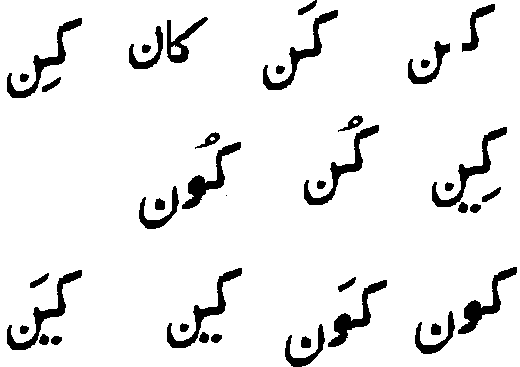
Here are the answers
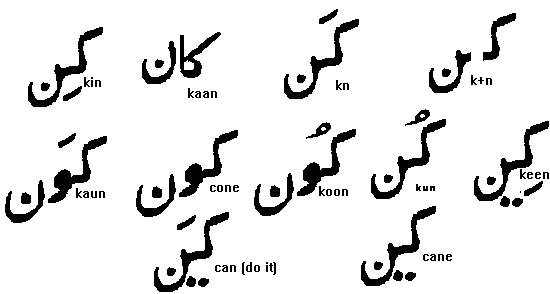 .
.One important point to note is that the zabar mark and i mark called a zer are similar but the zabar is on top of a letter while zer which signifies i is below.
You can make similar lessons yourself by using a Urdu font. Open windows character map program - its in the windows directory- and copy some letters . Paste them into a windows paintbrush program using the text tool and save as a monochrome bitmap file. Open this file in thumbs or paint shop pro and save as a gif file. For really large letters you need Universal word program.
Lesson 2..Home
No comments:
Post a Comment